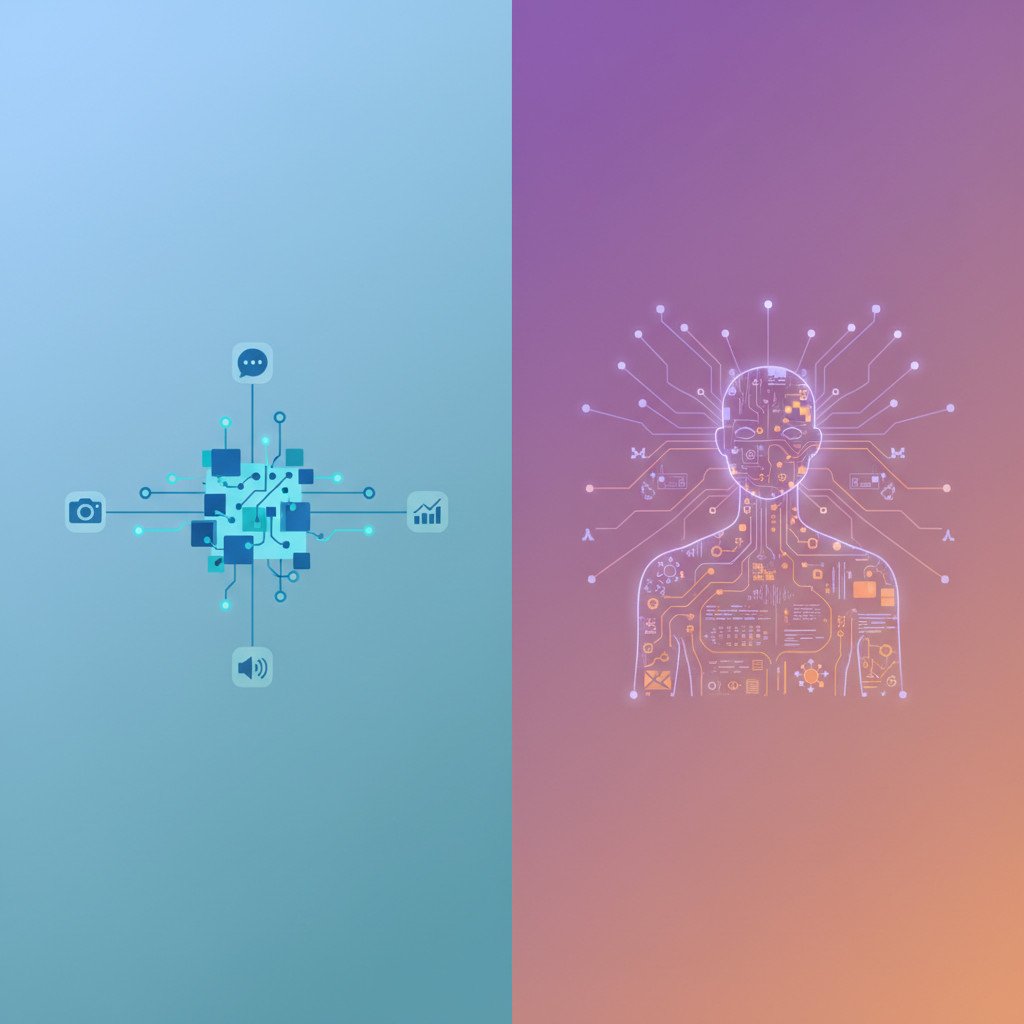AI vs AGI: differences, capabilities, and breakthroughs across industry is a phrase that captures a major shift in technology today. Businesses, healthcare providers, researchers, and governments now weigh narrow AI tools against the promise of Artificial General Intelligence.
While narrow AI excels at tasks like language translation, image analysis, and recommendation, AGI aims to match human adaptability across domains. As a result, companies invest in models, data infrastructure, and safety research to balance innovation and risk. Moreover, breakthroughs in models and hardware accelerate capabilities, yet they also raise ethical and governance questions about fairness, transparency, and control.
This guide explains core concepts, compares strengths and limits, and highlights real industry use cases. Readers will find clear definitions, practical examples from finance, biotech, and manufacturing, plus recent milestones driving progress. Along the way we unpack terms such as machine learning, diffusion models, and model scaling. By the end, you will understand where current AI shines, what AGI could change, and which breakthroughs matter most for society, policy makers, and builders.
AI vs AGI: differences, capabilities, and breakthroughs across industry (Core distinctions)
Artificial Intelligence usually refers to systems built for specific tasks. They optimize for a narrow objective. For example, recommendation engines, image classifiers, and chatbots focus on defined problems. In contrast, Artificial General Intelligence aims to perform across many domains. AGI would learn new tasks quickly and adapt without task specific retraining.
Key differences at a glance
-
Scope and purpose
- AI focuses on narrow tasks. It performs well on defined benchmarks. However, it cannot generalize broadly.
- AGI aims for broad competence. It should transfer skills and reason across domains.
-
Learning and adaptability
- Current AI learns from large labeled or unlabeled datasets. It often requires heavy supervision or fine tuning.
- AGI would learn like a person. It would generalize from few examples and from experience.
-
Evaluation and benchmarks
- AI is judged on task metrics like accuracy and recall. Benchmarks drive model improvements.
- AGI needs holistic evaluation across multiple cognitive abilities and contexts.
-
Risks and governance
- AI introduces bias, privacy, and safety concerns within its use cases.
- AGI raises broader societal risks and governance issues because of its generality.
Reputable perspectives
OpenAI notes that GPT 4 has strong abilities yet real limits, stating “it is not fully reliable” and it “can suffer from hallucinations”. See OpenAI GPT-4 Paper for details. DeepMind emphasizes a careful path toward AGI and the need for safety research. Read more at DeepMind AGI Blog. Finally, the Stanford AI Index tracks progress and benchmarks across fields. Explore their findings at Stanford AI Index.
| Parameter | Narrow AI (Artificial Intelligence) | AGI (Artificial General Intelligence) |
|---|---|---|
| Definition | Systems built for specific tasks and goals | Hypothetical systems with broad, human-like generality |
| Capabilities | High performance on limited tasks; excels at pattern recognition | General reasoning, transfer learning, and problem solving across domains |
| Applications | Image recognition; language models; recommendation; diagnostics | Cross-domain research, autonomous scientific discovery, adaptable assistants |
| Adaptability | Low without retraining; task specific | High; learns new tasks quickly with few examples |
| Learning methods | Supervised, unsupervised, reinforcement, fine tuning | Continual, meta-learning, causal reasoning (expected) |
| Data needs | Large labeled datasets or pretraining corpora | Diverse, multi-modal experiences; efficient few-shot learning |
| Evaluation | Benchmarks like accuracy and F1 | Multi-domain, cognitive and safety evaluations |
| Industry use cases | Healthcare diagnostics, finance trading, ads, manufacturing | Future scenarios: general automation, research acceleration, complex planning |
| Risks | Bias, privacy leaks, overfitting, hallucinations | Systemic societal risks, control, misuse, ethical governance |
| Maturity | Widely deployed today | Research stage; debated timeline |

Recent Breakthroughs in AI and Their Impact on Business
Recent breakthroughs in AI now power concrete business outcomes. For example, generative language models improved customer support and content creation. As a result, many companies report faster response times and higher throughput. The scale of adoption shows the breadth of AI capabilities. See market estimates at TwinStrata AI Market Size Statistics for details.
- Healthcare
- Improved diagnostic accuracy and speed: models reduce time to diagnosis and increase detection sensitivity in targeted workflows, enabling faster treatment decisions [citation].
- Genomic variant detection: tools like DeepSomatic produce several fold more high confidence somatic variant calls, improving precision medicine insights [citation].
- Imaging triage and workflow automation: AI prioritizes urgent scans, lowering radiologist backlog and shortening time to intervention [citation].
- Finance
- Fraud detection and prevention: real time models cut false positives and reduce monetary losses by improving anomaly detection precision [citation].
- Algorithmic signal extraction: machine learned strategies improve execution latency and signal to noise for short horizon trading strategies [citation].
- Compliance automation: automated monitoring reduces manual review hours and speeds suspicious activity flagging [citation].
- Manufacturing
- Predictive maintenance: sensor driven models predict failures earlier, reducing unplanned downtime and maintenance costs by a measurable percentage [citation].
- Quality inspection: computer vision catches defects at higher rates than manual inspection, increasing yield and lowering scrap [citation].
- Supply chain forecasting: multi source demand models reduce stockouts and improve on time delivery metrics [citation].
- Marketing
- Content generation and personalization: generative models cut creative turnaround time and increase campaign throughput [citation].
- Targeting lift: personalized recommendations raise conversion rates and lifetime value in tested campaigns [citation].
- Customer support automation: conversational AI reduces average response time and lowers support costs while maintaining satisfaction [citation].
These tangible industry gains also intensify the need for robust safety, transparency, and governance frameworks to manage bias, privacy, and systemic risk [citation].
Healthcare has seen some of the most vivid gains. Deep learning models now aid diagnostics and genomic analysis. For instance, DeepSomatic improved somatic mutation detection in cancer research. This method increased high confidence variant calls by several fold. Learn more at TGen News on DeepSomatic. Consequently, clinicians can access richer variant calls and better treatment insights.
Finance uses AI for fraud detection and trading strategies. Models analyze market microstructure and customer behavior at scale. Therefore, firms reduce losses while improving personalization. Meanwhile, marketing teams deploy generative models to create tailored campaigns. About 40 percent of marketers now use AI daily, and many say it reduces creative time. Source: Planable AI Statistics.
Manufacturing benefits from predictive maintenance and process optimization. AI models detect anomalies in sensor streams before failures occur. As a result, factories cut downtime and increase yield. In addition, AI improves supply chain forecasting with multi source data.
What about AGI breakthroughs in industry? AGI remains aspirational yet influences roadmaps and research. Organizations invest in meta learning, continual learning, and multi modal models to approach generality. For example, research labs prioritize safety and alignment while scaling models. The OpenAI GPT 4 paper highlights strengths and key limitations. Review the technical notes at OpenAI GPT-4 Paper.
Taken together, these advances show how AI capabilities shift industry practices. However, broader AGI adoption faces technical and governance hurdles. Therefore, industry leaders balance innovation with safety research and public benefit. For broader trend tracking, consult the Stanford AI Index and global statistics at Internet Economics AI Statistics.
In conclusion, the distinction between AI vs AGI: differences, capabilities, and breakthroughs across industry underscores a transformative era in technology. Today, AI systems are deeply embedded in business processes, significantly enhancing tasks through precision and efficiency. From optimizing supply chains to personalizing customer experiences, the impact of AI is ubiquitous.
Emp0 positions at the forefront of leveraging these AI innovations. As a full-stack, brand-trained AI worker, Emp0 delivers ready-made AI tools designed to automate and enhance sales and marketing operations. These advanced capabilities enable businesses to grow by focusing resources and improving customer engagement.
Employing AI solutions from Emp0 empowers enterprises to streamline workflows, enhance analytic insights, and automate repetitive tasks, thereby boosting strategic efforts and scaling beyond conventional limits. Moreover, their expertise ensures seamless integration and alignment with unique business goals, driving sustainable success in the digital economy.
For more insights into how Emp0 catalyzes business growth with cutting-edge AI capabilities, visit their website and blog. Discover how AI is reshaping industries and explore Emp0’s contributions to this vital evolution. Explore trusted platforms for further updates on their innovations and applications.
Frequently Asked Questions (FAQs)
This FAQ answers common queries about AI vs AGI: differences, capabilities, and breakthroughs across industry.
What is the core difference between AI and AGI?
AI refers to systems built for specific tasks. AGI refers to a hypothetical system with broad, human-like generality. AI excels at narrow tasks. However, AGI would transfer skills across many domains.
Can current AI evolve into AGI and when might that happen?
Researchers debate timelines and feasibility. Some progress uses meta learning and multi-modal models. Yet substantial gaps remain in reasoning, common sense, and continual learning. See OpenAI’s GPT 4 notes for current limits here and DeepMind’s responsible approach here.
How do industries use AI today and what changes could AGI bring?
Healthcare uses AI for diagnostics and genomics. Finance uses it for fraud detection and trading. Marketing uses generative models for content. AGI could automate complex research tasks and multi-step planning across domains.
What are the main risks and governance concerns?
AI brings bias, privacy, and safety issues. AGI raises wider governance challenges. Therefore, experts call for safety research, transparency, and public benefit frameworks. The Stanford AI Index tracks progress and policy signals here.
How should businesses adopt AI responsibly?
Start with clear goals and good data. Pilot small, measure outcomes, and scale iteratively. Also, prioritize alignment and human oversight. Finally, choose partners that provide secure, brand-trained solutions for sales and marketing automation.

